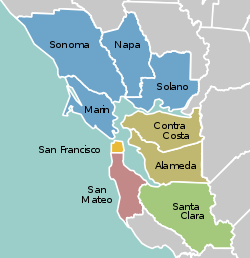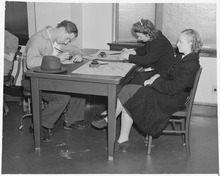Portal:San Francisco Bay Area
The San Francisco Bay Area Portal  The San Francisco Bay Area (referred to locally as the Bay Area) is a populous region surrounding the San Francisco and San Pablo estuaries in Northern California. The region encompasses the major cities and metropolitan areas of San Jose, San Francisco, and Oakland, along with smaller urban and rural areas. The Bay Area's nine counties are Alameda, Contra Costa, Marin, Napa, San Francisco, San Mateo, Santa Clara, Solano, and Sonoma. Home to approximately 7.68 million people, the nine-county Bay Area contains many cities, towns, airports, and associated regional, state, and national parks, connected by a network of roads, highways, railroads, bridges, tunnels, and commuter rail. The combined statistical area of the region is the second-largest in California (after the Greater Los Angeles area), the fifth-largest in the United States, and the 43rd-largest urban area in the world with 8.80 million people. The Bay Area has the second-most Fortune 500 companies in the United States, after the New York metropolitan area, and is known for its natural beauty, liberal politics, entrepreneurship, and diversity. The area ranks second in highest density of college graduates, after the Washington, D.C. metropolitan area and performs above the state median household income in the 2010 census; it includes the five highest California counties by per capita income and two of the top 25 wealthiest counties in the United States. Based on a 2013 population report from the California Department of Finance, the Bay Area is the only region in California where the rate of people migrating in from other areas in the United States is greater than the rate of those leaving the region, led by Alameda and Contra Costa counties. (more...) Selected article Most of the content on YouTube has been uploaded by individuals, but media corporations including CBS, the BBC, Vevo, Hulu, and other organizations offer some of their material via YouTube, as part of the YouTube partnership program. Unregistered users can watch videos, and registered users can upload an unlimited number of videos. Videos considered to contain potentially offensive content are available only to registered users affirming themselves to be at least 18 years old. YouTube, LLC was bought by Google for US$1.65 billion in November 2006 and now operates as a Google subsidiary. (more...) Selected biography Harvey Bernard Milk (May 22, 1930 – November 27, 1978) was an American politician who became the first openly gay person to be elected to public office in California when he won a seat on the San Francisco Board of Supervisors. Politics and gay activism were not his early interests; he was not open about his homosexuality and did not participate in civic matters until around the age of 40, after his experiences in the counterculture of the 1960s. Milk moved from New York City to settle in San Francisco in 1972 amid a migration of gay men to the Castro District. He took advantage of the growing political and economic power of the neighborhood to promote his interests, and ran unsuccessfully for political office three times. His theatrical campaigns earned him increasing popularity, and Milk won a seat as a city supervisor in 1977, part of the broader social changes the city was experiencing. Milk served almost 11 months in office and was responsible for passing a stringent gay rights ordinance for the city. On November 27, 1978, Milk and Mayor George Moscone were assassinated by Dan White, another city supervisor who had recently resigned but wanted his job back. Milk's election was made possible by and was a key component of a shift in San Francisco politics. Despite his short career in politics, Milk became an icon in San Francisco and a martyr in the gay community. In 2002, Milk was called "the most famous and most significantly open LGBT official ever elected in the United States". Anne Kronenberg, his final campaign manager, wrote of him: "What set Harvey apart from you or me was that he was a visionary. He imagined a righteous world inside his head and then he set about to create it for real, for all of us." Milk was posthumously awarded the Presidential Medal of Freedom in 2009. (more...) Selected city Oakland is a major West Coast port city in the U.S. state of California. Oakland is the third largest city in the San Francisco Bay Area, the eighth-largest city in California, and the 45th-largest city in the U.S., with a population of 413,775 as of 2014[update]. It serves as a trade center for the San Francisco Bay Area; its Port of Oakland is the busiest port for San Francisco Bay, all of Northern California, and fifth busiest in the United States. Incorporated in 1852, Oakland is the county seat of Alameda County. It is also the principal city of the Bay Area Region known as the East Bay. The city is situated directly across the bay, six miles (9.7 km) east of San Francisco. (more...) Selected image
The Bay Area by year2008
 
Selected historical imageDid you know...
Previous Did you know... 
Selected periodic event The Mill Valley Film Festival in Mill Valley is an annual, non-competitive film festival presented by the California Film Institute (pictured). Known as a filmmakers’ festival, the 11-day festival was founded in August 1978 by Mark Fishkin. Quote
~ Frank Norris, McTeague (1899)
Selected multimedia fileBay Area regions, geographic features and protected areasRelated PortalsWikiProject
Things you can do *Write an article on a Bay Area-related subject Selected panoramaSan Francisco Bay Area categoriesBay Area | San Francisco Bay | San Francisco | San Jose | Oakland | Cities | Census-designated places | Historic Places | National Landmarks | Counties: Alameda | Contra Costa | Marin | Napa | San Mateo | Santa Clara | Solano | Sonoma
Architecture | Attractions | Books | Culture | Economy | Education | Environment | Events & Festivals | Geography | Government | History | Landmarks | Law | Mass media | Military | Music | Organizations | Parks | People | Politics | Science | Sports | Transport
Full category tree
Select [►] to view the full category tree.
Associated WikimediaThe following Wikimedia Foundation sister projects provide more on this subject:
Discover Wikipedia using portals |
- All portals
- San Francisco Bay Area portal
- San Francisco Bay Area portal selected article pages
- San Francisco Bay Area portal selected biography pages
- San Francisco Bay Area portal selected city pages
- San Francisco Bay Area portal selected picture pages
- San Francisco Bay Area portal years pages
- San Francisco Bay Area portal selected historical image pages
- San Francisco Bay Area portal did you know pages
- San Francisco Bay Area portal festivals pages
- San Francisco Bay Area portal quotes pages
- San Francisco Bay Area portal selected multimedia pages
- San Francisco Bay Area portal selected panorama pages
- California portals
- San Francisco Bay Area
- United States portals by city

















































